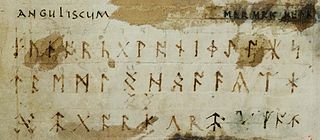Collation is the assembly of written information into a standard order. Many systems of collation are based on numerical order or alphabetical order, or extensions and combinations thereof. Collation is a fundamental element of most office filing systems, library catalogs, and reference books.
Alphabetical order is a system whereby character strings are placed in order based on the position of the characters in the conventional ordering of an alphabet. It is one of the methods of collation. In mathematics, a lexicographical order is the generalization of the alphabetical order to other data types, such as sequences of digits or numbers.
Acrophony is the naming of letters of an alphabetic writing system so that a letter's name begins with the letter itself. For example, Greek letter names are acrophonic: the names of the letters α, β, γ, δ, are spelled with the respective letters: αλφα (alpha), βήτα (beta), γάμμα (gamma), δέλτα (delta).
It is thought that the Arabic alphabet is a derivative of the Nabataean variation of the region, which descended from the Phoenician alphabet, which, among others, gave rise to the Hebrew alphabet and the Greek alphabet.
The history of alphabetic writing goes back to the consonantal writing system used for Semitic languages in the Levant in the 2nd millennium BCE. Most or nearly all alphabetic scripts used throughout the world today ultimately go back to this Semitic proto-alphabet. Its first origins can be traced back to a Proto-Sinaitic script developed in Ancient Egypt to represent the language of Semitic-speaking workers in Egypt. This script was partly influenced by the older Egyptian hieratic, a cursive script related to Egyptian hieroglyphs.

The Abjad numerals, also called Hisab al-Jummal, are a decimal alphabetic numeral system/alphanumeric code, in which the 28 letters of the Arabic alphabet are assigned numerical values. They have been used in the Arabic-speaking world since before the eighth century when positional Arabic numerals were adopted. In modern Arabic, the word ʾabjadīyah (أبجدية) means 'alphabet' in general.

Latin or Roman script, is a set of graphic signs (script) based on the letters of the classical Latin alphabet. This is derived from a form of the Cumaean Greek version of the Greek alphabet used by the Etruscans.

A semi-syllabary is a writing system that behaves partly as an alphabet and partly as a syllabary. The term has traditionally been extended to abugidas, but for the purposes of this article it will be restricted to scripts where some characters are alphabetic and others are syllabic.
An abecedarian hymn is a hymn that begins with the letter A, and each verse or clause following begins with the next letter of the alphabet.
The ISO basic Latin alphabet is a Latin-script alphabet and consists of two sets of 26 letters, codified in various national and international standards and used widely in international communication. They are the same letters that comprise the English alphabet.
The Armenian alphabet is an alphabetic writing system used to write Armenian. It was developed around 405 AD by Mesrop Mashtots, an Armenian linguist and ecclesiastical leader. The system originally had 36 letters; eventually, three more were adopted. The alphabet was also in wide use in the Ottoman Empire around the 18th and 19th centuries.
The Hawaiian alphabet is an alphabet used to write Hawaiian. It was adapted from the English alphabet in the early 19th century by American missionaries to print a bible in the Hawaiian language.
The goal of braille uniformity is to unify the braille alphabets of the world as much as possible, so that literacy in one braille alphabet readily transfers to another. Unification was first achieved by a convention of the International Congress on Work for the Blind in 1878, where it was decided to replace the mutually incompatible national conventions of the time with the French values of the basic Latin alphabet, both for languages that use Latin-based alphabets and, through their Latin equivalents, for languages that use other scripts. However, the unification did not address letters beyond these 26, leaving French and German Braille partially incompatible, and as braille spread to new languages with new needs, national conventions again became disparate. A second round of unification was undertaken under the auspices of UNESCO in 1951, setting the foundation for international braille usage today.
A Latin-script alphabet is an alphabet that uses letters of the Latin script. The 21-letter archaic Latin alphabet and the 23-letter classical Latin alphabet belong to the oldest of this group.

Alphabetic numeral systems are a type of numeral systems that were developed in the antiquity and during the early Middle Ages. In this type of systems, glyphs of the numerals are letter-signs of a writing system. Alphabet of a writing system is ordered to numerical values, so numbers are represented by these character sets. Unlike acrophonic systems, where a numeral is represented with the first letter of the lexical name of the numeral, in these systems letter-numerals follow the order of the alphabet. Its history spans over two thousand years, from the development of the Greek numerals around 600 BC to the present day. After appearing of the Arabic and western positional numeral systems, their use of contexts became increasingly limited, for religious functions, pagination or stichometry.
This page is based on this
Wikipedia article Text is available under the
CC BY-SA 4.0 license; additional terms may apply.
Images, videos and audio are available under their respective licenses.




